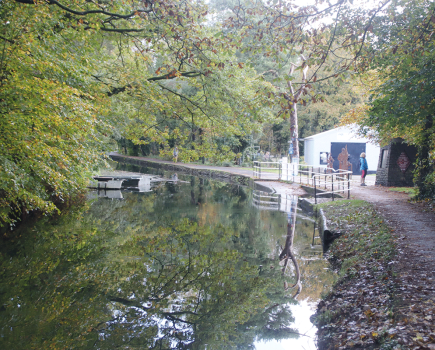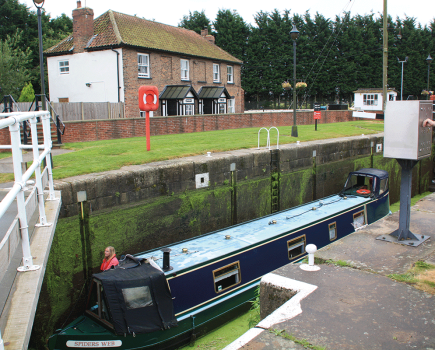Is the Lichfield Canal tying itself in knots? No, on the contrary, it’s enjoying some success in unravelling the problems of roads and railways getting in the way of restoration…

You may have looked at the headline above and wondered exactly how a canal could possibly go under itself. Is it like one of those mountain railways, spiralling around and crossing itself to gain height? Well, no, nothing like that. But if you’d been on the M6 Toll motorway on a wintry 2nd of March you might, in an odd way, have witnessed the curious sight of one part of the future Lichfield Canal going under another part of it. A convoy of lorries carrying concrete culvert segments, destined to form part of two new canal bridges, was to be seen passing under the new aqueduct built in 2003 which will one day carry the canal’s reopened route over the motorway.
And in an odd way, this rather symbolises the successes and challenges facing the Lichfield & Hatherton Canals Restoration Trust as they work to restore a short but important canal; one that has been rather badly knocked about at the hands of other transport systems in the decades since it closed.

But before we get into the details of where those concrete segments were heading, we’ll elaborate on those three aspects: short, important, and knocked-about. It’s certainly short: the Lichfield Canal, historically the abandoned eastern end of the Wyrley & Essington Canal (part of the Birmingham Canal Navigations) runs for just six miles from Huddlesford Junction (where it leaves the Coventry Canal) to Ogley Junction (where it joins the surviving length of the W&E and its Anglesey Branch). OK so it’s got 30 locks in that distance, but it’s a lot shorter than many current restoration schemes – for example the Wey & Arun which we featured last time totals 23 miles, and several are considerably longer.
It’s also important. The northern parts of the BCN network are underused, even though in many places they run through rural areas and don’t live up to the Black Country industrial stereotype which might put boaters off visiting them. And local waterways supporters believe that at least in part, it’s because they’re out on a limb, with a need to cruise through Birmingham, Wolverhampton or Walsall to get there – and again to get out. Open up the Lichfield and you’ve got an easy link into the network from the Coventry, Trent & Mersey and Staffs & Worcs canals. Open up the Hatherton too (and that’s all part of LHCRT’s long-term plan – hence its name), and you’ve created all sorts of new through routes across the Midlands – as well as a cruising ring via Hatherton, Lichfield, Fradley and Great Haywood that neatly circles Cannock Chase.

And it’s not just about the through route: the canal will also open a connection to the historic city of Lichfield, which is just too far away from the Coventry for most boaters to visit it – but will be just 15 minutes walk from the restored canal.
However as we said earlier, it’s been badly knocked-about. Passing through a densely populated area, with multiple main roads criss-crossing it (plus a couple of railways too), the Lichfield was always likely to suffer when those roads needed widening, straightening or bypassing with new routes. Even since restoration began, it’s often been one battle after another to get provision for navigation where new roads cross. But LHCRT has faced them with a series of successful appeals, fronted by its patron the actor David Suchet. First there was the new motorway aqueduct mentioned above plus bridges carrying the same motorway over the Hatherton Canal; then the navigable concrete culvert under the Birmingham Road; the latest is the £1m ‘Tunnel Vision’ appeal to pay for a new navigable culvert which will tunnel under the Lichfield – Birmingham railway line (and for which Canal Boat subscribers should find an Appeal leaflet in this issue).

But it isn’t just about fighting battles against road-builders (not to mention railway builders: yes, HS2 is in the mix too!) At the same time, LHCRT has been working towards reinstating some of the missing bridges from earlier road construction, as well as making some excellent progress with restoring the lengths of canal in between. And it could do even more with more volunteers – especially any with engineering experience to help with planning and designing the trickier bits.
To get a feel for the challenges, but also how the Trust is coping with them, let’s take a tour of the route – starting at Huddlesford, where it leaves the Coventry Canal.

The first couple of hundred yards are still in water and used for moorings by Lichfield Cruising Club, whose members have a good relationship with LHCRT – to the point of welcoming visiting Waterway Recovery Group volunteers to use their clubhouse (a couple of converted canal cottages) as weekend accommodation. There will need to be new moorings created as part of the reopening of this length to normal boat traffic, but with a new bridge built to Cappers Lane across the canal a few years ago, the first lock surviving in restorable condition, and a second-hand liftbridge installed some years ago, there ought to be no major problems getting the first section open.
There ought to. But then the plans for HS2 were announced, and the brand new Cappers Lane Bridge looks set to bite the dust before a single boat passes through it. On the plus side, though, following negotiations also involving the Canal & River Trust and the Inland Waterways Association, when the railway is constructed its builders will create a new canal bridge and 350m replacement length of canal.
There now follows the first of several diversions from the original route which the restoration will require – and the first part of this was dug a number of years ago. It leads towards Darnford Lane, at a lower level than the old line so that it can cross under the lane via a new bridge. And that’s where those concrete culvert segments on the lorries were heading. They were left over from the Birmingham Road culvert some years ago, and have been stored in a former industrial site ever since. But the need for that site to be cleared meant LHCRT needed to shift them. They are now laid out in a newly excavated length of the new canal, a hardstanding was created for the crane which unloaded them, and they are ready to be used to create the new road bridge – probably in a couple of years’ time.
As the canal approaches the edge of Lichfield, it encounters two more major challenges in the form of the A38 and A51 main roads. Getting the canal under these will involve another diversion. It will also need some serious amounts of funding not available at present, but in the meantime the Trust has carried out a great deal of the excavation for a pair of new locks situated in a corner of Darnford Park, on a site between the two road crossings. These will raise the canal so that it will eventually emerge from the new A51 bridge at the right level to meet up with a section which has been a main focus for LHCRT’s volunteers in recent years.
A newly built length leads to a sharp right turn, where the canal picks up the original route to climb through two restored locks, all of this set in the new Borrowcop Canal Park with the restored towpath already a popular local walk.
A minor road crosses the canal above the locks at a low level, where originally there was a hump-backed bridge, not something the highways authorities would agree to now. The solution to this is likely to involve relocating a lock from one side of the road to the other, to provide headroom under a new bridge. Beyond, a well-preserved (albeit partly infilled) section passes through the fringes of Lichfield.
But then another diversion is needed (as the old canal has been built on), and its construction is linked to the Lichfield Southern Bypass road which has been opening in stages for some time – the new Birmingham Road canal culvert mentioned earlier was built as part of these road works.
The next section of the bypass will take it under the Lichfield to Birmingham railway line. This provides an option to insert a canal tunnel through the railway embankment at the same time, bringing the price tag down to a relatively modest £1m. But time is of the essence: the money needs to be raised by 2019 in time for the necessary planning to take place before construction, probably later the same year – hence the Tunnel Vision Appeal.
Subject to the funds for the rail crossing being raised, the bypass should actually facilitate restoration of this length, with space reserved for it along the roadside. There will be four new locks needed to replace those on the original route.
The canal then reaches Fosseway Heath, a new volunteer worksite where a planned WRG Canal Camp this summer will help with rebuilding the canal walls and reinstating the channel, initially as a nature reserve. Just beyond here, a lock was rebuilt as one of LHCRT’s earliest projects, and much of the next mile or so of canal survives in a reasonable state, although the locks are buried and there has yet to be any restoration work carried out.
Around Muckley things get trickier again, with a new crossing under the A5 needed, and also one under the A461 by the Boat Inn.
The A461 crossing will also need the canal level to be lowered to provide enough headroom under the canal (originally there was another hump-backed bridge) – and work has already begun on preparations for this. A new lock will be built next to the Boat Inn, and excavation and construction of retaining walls is under way.
This is the start of a much better preserved length at Summerhill where the channel has survived intact, and where volunteers (including LHCRT’s own team, WRG visitors and ‘corporate’ volunteers from local firms) have made a huge difference in the last couple of years. The canal has been recovered from impenetrable thickets, the towpath reinstated, the hedge laid, an old wharf rebuilt, and a new embankment and culvert built to take the canal over the Crane Brook. It ends at the M6 Toll Aqueduct – the one that the lorries were passing underneath at the start of this article. All it needs is one new lock to link the canal to the aqueduct – but it will be a deep one, with a rise of around 8m. Planning is under way, and as a first stage the towpath is to be connected up to the aqueduct by a footbridge.
Beyond there, it will be a case of restoring the final flight of locks (most of which are believed to survive buried), and a final new road bridge needed for Barracks Lane (the road will probably be diverted to avoid the need for another hump-backed bridge). The very last lock is situated in the gardens of two former canal cottages – both of which are now owned by LHCRT, facilitating restoration of the canal.
And a few yards beyond there, the canal meets the navigable length of the Wyrley & Essington at Ogley Junction – job done!
You could be forgiven for reading this rather daunting-sounding description of the route, and feeling rather sceptical about all proposed diversions, new locks and road crossings to be reinstated. But this is a canal restoration which has seen off threats from a motorway and a high speed railway, has raised cash for new road bridges, is half way to paying for a tunnel under a railway – and in between, has kept up the volunteer work on the less difficult lengths. And it’s only six miles long – there are other canal restorations which will need more than that in diversions alone.
And it’s the canal that went under itself – so surely anything’s possible…
Image(s) provided by:
Martin Ludgate








